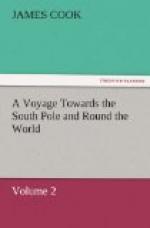We were hardly through the passage before we got a fresh breeze at south. That moment all the natives made haste to be gone, and we steered to the west; all sails set. I had some thoughts of touching at Amsterdam, as it lay not much out of the way; but as the wind was now, we could not fetch it; and this was the occasion of my laying my design aside altogether.
Let us now return to Anamocka, as it is called by the natives. It is situated in the latitude of 20 deg. 15’ S.; longitude 174 deg. 31’ W., and was first discovered by Tasman, and by him named Rotterdam. It is of a triangular form, each side whereof is about three and a half or four miles. A salt-water lake in the middle of it occupies not a little of its surface, and in a manner cuts off the S.E. angle. Round the island, that is, from the N.W. to the S., round by the N. and E., lie scattered a number of small isles, sand-banks, and breakers. We could see no end to their extent to the N.; and it is not impossible that they reach as far S. as Amsterdam or Tongatabu. These, together with Middleburg or Eaoowee, and Pylstart, make a group, containing about three degrees of latitude and two of longitude, which I have named the Friendly Isles or Archipelago, as a firm alliance and friendship seems to subsist among their inhabitants, and their courteous behaviour to strangers entitles them to that appellation; under which we might, perhaps, extend their group much farther, even down to Boscawen and Keppell’s Isles discovered by Captain Wallis, and lying nearly under the same meridian, and in the latitude of 15 deg. 53’; for, from the little account I have had of the people of these two isles they seem to have the same sort of friendly disposition we observed in our Archipelago.
The inhabitants, productions, etc. of Rotterdam, and the neighbouring isles, are the same as at Amsterdam. Hogs and fowls are, indeed, much scarcer; of the former having got but six, and not many of the latter. Yams and shaddocks were what we got the most of; other fruits were not so plenty. Not half of the isle is laid out in inclosed plantations as at Amsterdam; but the parts which are not inclosed, are not less fertile or uncultivated. There is, however, far more waste land on this isle, in proportion to its size, than upon the other; and the people seem to be much poorer; that is, in cloth, matting, ornaments, etc. which constitute a great part of the riches of the South-Sea islanders.
The people of this isle seem to be more affected with the leprosy, or some scrophulous disorder, than any I have seen elsewhere. It breaks out in the face more than any other part of the body. I have seen several whose faces were ruined by it, and their noses quite gone. In one of my excursions, happening to peep into a house where one or more of them were, one man only appeared at the door, or hole, by which I must have entered, and which he began to stop up, by drawing several parts of a cord across it.




